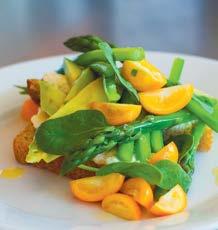
18 minute read
Edible Notables
Edible Notables Down by the Boardwalk
The Picnic Basket offers a true taste of Santa Cruz
Advertisement
By Elizabeth Limbach
Co-creators: Picnic Basket owners Zach Davis and Kendra Baker. The Picnic Basket’s Market Salad.
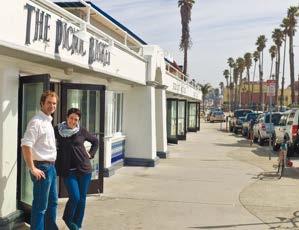
The Santa Cruz Beach Boardwalk is the city’s most iconic tourist attraction—drawing three million visitors each year—and yet its dining options don’t exactly scream “Santa Cruz.”
Despite the bounty of fresh local and organic foods in the area, the amusement park is unsurprisingly lined with funnel cakes, corn dogs, cotton candy and an astounding array of deep-friend specialties. Luckily for those who like their roller coasters—but prefer to fuel up on something other than deep-fried Twinkies afterward— the Boardwalk area now boasts a restaurant that actually embodies the region’s culinary potential.
The year-old Picnic Basket is the second gastronomic venture from business partners Kendra Baker and Zachary Davis, who opened Santa Cruz’s Penny Ice Creamery in August 2010. Baker is a graduate of the Johnson & Wales University’s College of Culinary Arts in Rhode Island who got her start cooking for Santa Cruz’s celebrated Gabriella Café and has developed a reputation for being an extremely creative chef. Davis is a veteran of the Bay Area Internet startup scene and holds an MBA in sustainable enterprise from Dominican University of California in San Rafael. The two were friends for almost a decade before they opened the Penny, and launching The Picnic Basket has fulfilled a dream they’ve long shared.
“We’ve always been in love with the idea that we could personally know the people who grow and produce what we eat, and we wanted to see if that was still possible,” says Davis. “Now, knowing the people who bake the bread, raise the chickens, grow the fruits and vegetables, brew the beer, and make the wine, we feel like we’ve made our vision come true.”
The café’s unique creations (such as the popular Ricotta Beet Panini) are assembled with ingredients like local organic produce from Route 1 Farms, Happy Boy Farms and Dirty Girl Produce, bread from Companion Bakeshop (most notable is the Picnic Loaf— a multi-grain sourdough loaf created especially for the restaurant) and meats from nearby sustainable operations like el Salchichero and Rib King. Foraged ingredients add to the distinct neighborhood menu, as do the libations and desserts, which include Verve coffee and Santa Cruz Mountain Brewery beers, and a rotation of nine ice cream flavors that are freshly made from local, seasonal and organic ingredients at the Penny.
The peak tourism months bring droves of out-of-towners to the Santa Cruz beachfront—and The Picnic Basket. But it’s also a favorite among locals—including its local artisanal suppliers.
“We definitely felt a degree of vulnerability starting a project that was so closely tied to our personal values,” says Davis, “so we feel tremendously grateful that folks appreciate what we are doing.”
Baker concurs: “It is pretty cool to see the pride and enthusiasm that our community has for what is happening here in Santa Cruz.”
Elizabeth Limbach is an award-winning journalist based in Santa Cruz.
The Picnic Basket 125 Beach St., Ste. B, Santa Cruz • 831.427.9946 www.thepicnicbasketsc.com
Edible Notables 2012 EDDY Awards
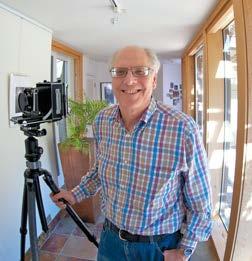
Jim Kasson’s tribute to Salinas Valley farm workers wins national prize
By Lisa Crawford Watson
It all started with a picture. A landscape, photographed through the window of a moving car. Some images were clear, others blurred, with directional distinction. Fascinated, Jim Kasson was determined to figure out how it was achieved.
For 18 months, Kasson stared at that photograph, the engineer in him piecing together a process that would have created the composition, while the artist appreciated the effects. In the end, he pulled out his 4x5 Linhof Technika camera and began making his own.
Kasson eventually applied the technique to create a series of photos of Salinas Valley farm workers, which he called This Green Growing Land. A collection of the striking photos appeared in the inaugural issue of Edible Monterey Bay in Fall 2011. In March, the photo essay received the top non-cover photography prize in the 2012 national “EDDY” Excellence in Publishing Awards made by Edible Communities, the family of magazines of which Edible Monterey Bay is a member. The award was one of 20 editorial prizes for which 70 Edible magazines were under consideration.
The farm worker photos are reminiscent in style of impressionist paintings, both in their soft, abstracted beauty and in their elevation of often overlooked and taken-for-granted subjects.
“The selective blurring and muted colors render the workers anonymous, making the images less a portrayal of a particular time and place, and more an archetype…but the emphasis is on the workers and their relationship to the land and to the machinery,” Kasson wrote in an artist’s statement for the series.
Kasson took the photographs from a moving car, exposing the negatives at slow shutter speeds and using panning to emphasize some parts of the scene and to blur others. He printed the images on heavy paper with a color palette similar to that of pastels.
The Stanford-educated electrical engineer, who spent most of his career with Hewlett-Packard, Rolm and IBM, began photographing in earnest for his high school yearbook and, later, The Stanford Chaparral humor magazine. Later, in 1980, Kasson took a threemonth hiatus from work, built himself a dark room, bought a Hasselblad camera and got serious. Most of his earlier work was traditional, silver-based, black-and-white photography.
Today, Kasson relies on digital editing and printing processes, and he has moved away from using slow-motion photography techniques to create the blurred images he is after. Recently, he’s been compiling a body of work in a new, “staccato” style.
“I decided to come up with a different way of doing this,” Kasson says. “I learned how by inventing it. Each picture is a composite of some eight to 20 photographs taken within seconds of one another. I determine what is sharp and what is blurred by the way I line up the pictures when I overlay them.”
“I like to experiment,” Kasson explains. “My photography is all about coming up with an idea and not knowing how it will turn out, but playing with it until I do know. It is a lot like engineering — both technical and creative. In engineering, elegance is also important, an idea I value in photography as well.”
Equipped: Kasson and his 4x5 Linhof Technika.
Photo by Rob Fisher
To view Kasson’s work, go to www.kasson.com; to see the winning photo essay, go to www.ediblecommunities.com/montereybay/online-magazine/fall-2011/in-the-fields.htm.
Editor’s note: In addition to receiving the EDDY award for Kasson’s photo essay, Edible Monterey Bay was one of three finalists for EDDY Awards for Excellence in Publishing in the category of “Best Editorial— Beverage-Focused,” for “On the Vine, Grahm’s Gamble,” by Kurt Foeller (Edible Boston took home the prize) and “Best Editorial—New Column Creation” for “The Preservationist,” by Jordan Champagne of Happy Girl Kitchen Co. (Edible Manhattan won the honor). We congratulate our talented contributors and fellow publishers for this welldeserved recognition!
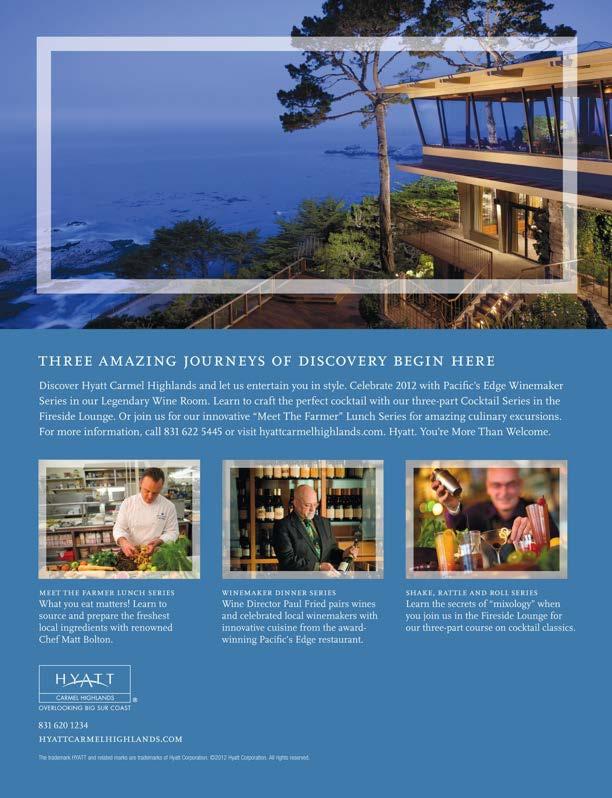
Edible Notables EDIBLE MONTEREY BAY ANNOUNCES 2012 LOCAL HEROES WINNERS
Chefs, nonprofits and farmers are among our readers’ choices
By Renee Brincks
Our heroes, from left: Jose Nunez, Tu Universal Organics/Everyone’s Harvest; GMO-Free SC’s Tarah Locke and Mary Graydon-Fontana; MEarth students; Montrio’s Tony Baker; Pinnacle Organics’ Phil Foster and Serendipity Farms’ Jamie Collins.
The votes are in, and Edible Monterey Bay congratulates the winners of our inaugural Local Heroes Awards, which were selected by readers through an online poll on our website!
“It means a tremendous amount to be honored in this way,” says Monterey Chef Tony Baker, who snapped up Best Chef/Restaurant, Best Food Artisan and Best Food Retailer awards for his work with Montrio Bistro and Baker’s Bacon. “It makes you feel that your work is worth it and that people are paying attention.” During 15 years at Montrio, Baker has been serving fresh, made-from-scratch dishes crafted with seasonal, organic produce, responsibly raised meats and sustainable seafood. Baker’s Bacon, which he launched last August to create an alternative to overly processed mass-market brands, follows similar principles. Thick cuts of meat are hand-seasoned with salt, sugar and spices, dry cured and slowly smoked over apple wood.
“Real food is my goal. It’s bringing us back to what food should be, which is minimally processed and, ideally, regional and local,” he says. “If you start with great ingredients, you don’t have to do a lot to them.”
The Local Heroes Awards are something that Edible magazines all across the U.S. and Canada have been conducting for several years, as a way to recognize local food producers and purveyors for their exceptional contributions to their communities.
While Baker swept three categories, three organizations split Best Nonprofit honors: GMO-Free Santa Cruz, MEarth at Hilton Bialek Habitat and Everyone’s Harvest.
GMO-Free Santa Cruz, led by Tarah Locke and Mary Graydon-Fontana, is garnering local support for a proposed California ballot initiative to require the labeling of genetically modified foods (GMOs). Currently, no such labeling is required, so there is no way for consumers to know if foods contain GMO ingredients unless sellers disclose it voluntarily. Since July, 120 volunteers have been trained to collect signatures.
“It’s like the whole movement toward eating locally and organically,” says Locke. “We’re pushing toward that kind of awareness.”
Encouraging awareness is also a goal of co-awardee MEarth, the environmental education nonprofit situated on the campus of Carmel Middle School. There, a small staff offers creative science and sustainability programs primarily aimed at students. In addition to an organic garden and native plant nursery, there’s a new green building with a living roof, solar panels, a rainwater catchment system and kitchen facilities that bring lessons to life.
“Our mission is to inspire students of all ages to understand, appreciate and protect the natural environment,” says MEarth Executive Director Andrea Lewis. “To have the work that we do validated through an award of this type is exceptionally gratifying.”
The Best Nonprofit recognition motivates Iris Peppard of Everyone’s Harvest to continue creating robust community outreach programs. Since launching the Marina Certified Farmers’ Market 10 years ago, her group has added others in Pacific Grove and Salinas. In 2010, Everyone’s Harvest introduced free farmers’ market cooking workshops as part of its Edible Education for Healthy Youth program. Chefs teach participants tasty new ways to enjoy produce sold right on site. (For more, see “Market Mania,” p. 20.)
“A lot of our farmers come from this area,” Peppard says. “We support them, and they support us.”
This year’s Best Farm/Farmer award goes to two popular local producers. Phil and Katherine Foster farm 250 acres in San Benito County, prioritizing fair wages and environmentally friendly growing practices. Their Pinnacle Organically Grown Produce sells at regional farmers’ markets and at their San Juan Bautista farm stand and Whole Foods. (For more about Foster and Pinnacle, please see “Reimagining San Benito County,” on p. 36.)
Co-honoree Jamie Collins started Serendipity Farms 11 years ago and currently sells her organic vegetables through a local community-supported agriculture (CSA) business and at Bay Area farmers’ markets. She specializes in nutrient-rich pea shoots, dandelion greens, kale and chard and plans to market fruit grown on her Aromas ranch in the coming years.
Over the past decade, Collins has watched enthusiasm for local foods flourish.
“Monterey County is just starting to hit its stride,” she says. “The momentum is there now, and it’s great to be a part of it.”
If you missed your chance to vote in this year’s Local Heroes Awards, please watch for more about the next vote, which will take place this fall, by following us on Facebook and Twitter. The magazine has some special plans for the 2013 Local Heroes Awards to announce!
Renee Brincks is a full-time freelance writer who covers food, travel and lifestyle topics.
For more information on the winners, go to: www.bakersbacon.com, www.everyonesharvest.com, www.labelgmos.org/gmofreesc, www.meearth.info, www.serendipityorganics.org and www.pinnacleorganic.com.
At the end of June, members of Congregation Beth Israel and their friends meet in the Carmel temple’s kitchen to begin baking bread and pastries from traditional recipes that will serve nearly 4,000 people.
The kitchen becomes an orchestration of activity, its rhythm kept by the clanging of pots and pans, while the melody dances on the voices of women sharing family stories, remembering the bubbies who “did it this way” and the memories of holidays and festivals gone by. As hands stir the pot, work the dough, form the crust, the spirit enters what is fondly called, “Jewish food for your soul.”
“I am a from-scratch person,” says Diana Rosenthal, who leads the baking. “I like getting my hands in it; the process of kneading the dough is an experiential thing. To be a good baker, you have to have your hands on product. I remember, my husband’s grandmother, the family’s best pie crust maker, used her eyes and sense of touch to tell things were just right.”
And so begins preparation for the annual Jewish Food Festival, the largest such celebration of Jewish food and culture in the region.
The one-day event, held on the fourth Sunday of every August, will celebrate it’s 25th anniversary this Aug. 26, and, as it does every year, will seek to celebrate and share Jewish culture with the wider community. Thousands of food lovers of all faiths are expected to flock to Beth Israel for the recreation of a traditional Jewish village, complete with costumes, music, dance, wedding enactments—and food.
“Food is a central part of Jewish culture,” says Beth Israel Rabbi Bruce Greenbaum. “Whatever we do, food is a component of it. It has taken time for it to become ingrained in American culture, but now it is… Non-Jews and Jews alike tend to enjoy Jewish food. What’s not to like about chicken soup?”
“I think if you look at the different ethnic festivals, what they all have in common is food,” says Rosenthal. “It unites people. Food is essential for our existence, yet the sharing of food has become ritualistic; we’re not just standing under a tree grabbing fruit. There are rituals of preparation, serving and communal eating. Food is something that bonds us, feeding the body and the soul at the same time. It strengthens family relationships and creates community.”
In a new twist, Beth Israel last year partnered with Monterey County Waste Management to “go green” by introducing compostable utensils, plates and napkins and by diverting waste from the landfill by capturing hundreds of plastic zip bags used for freezing food, for the “bag in bag” program.
“Rather than tossing all those zip bags,” says Donna Shore, “we rinsed them, and stuffed them in a larger plastic bag for recycling. This ‘greening’ is a new element in a well-oiled machine. Our efforts tie into Tikkun Olam, which is a Jewish value of repairing the earth, making it better than we found it. This calls us to take responsibility for our actions, to take care of the earth; it hurts our soul when we don’t. We felt good about this; we knew we had done a great job to minimize waste.”
What never goes to waste is the food.
Most people purchase their latkes or potato pancakes, challah bread, hamentashen and rugelach pastries, falafel, corned beef or pastrami sandwiches, chopped liver, matzoball soup and more to enjoy on site in the village, as they listen to music by performers including Alisa Fineman and Kimball Hurd.
Yet many also buy great quantities of food to take home for the evening meal or to be enjoyed during the days and weeks to come. At the end of the festival, any remaining food is donated to Dorothy’s Kitchen and other local shelters. Funds raised support educational programs in the synagogue, as well as the American Red Cross and MAZON Jewish food bank.
Like a Jewish Brigadoon, on this day in August, the sun rises and the fog clears, revealing a bustling village that will die with the day, slipping into obscurity with the setting sun, for another year. Yet behind the scenes, the culture continues, with food, faith and fellowship.
Edible Notables Feasting on Fellowship
The Jewish Food Festival celebrates 25 years of feeding the soul
By Lisa Crawford Watson
Open-air deli: Lester Tockerman and an array of food offerings The 25th Annual Jewish Food Festival
Congregation Beth Israel 5716 Carmel Valley Rd., Carmel Sunday, Aug. 26, 10:30am–4pm 831.624.2015 • www.carmelbethisrael.org
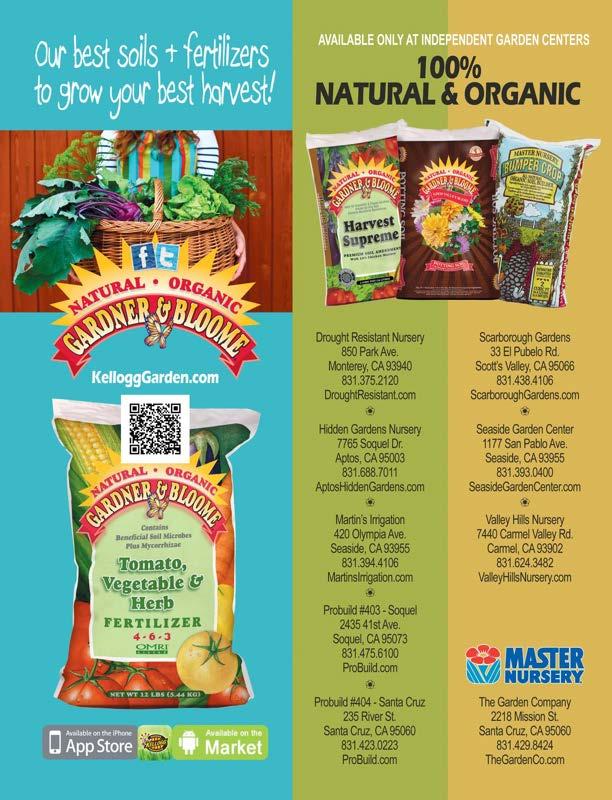
Edible Notables Eat, Bake, Commune
Breaking bread with Companion Bakeshop’s Erin and Jeremy Lampel
By Cameron Cox

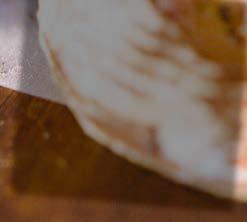
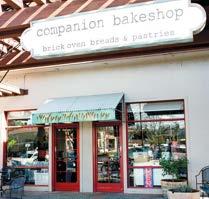



Jeremy and Erin Lampel.
Gone are the days of the one-track mercantile. Garden nurseries serve single-drip coffee and small-batch ice cream…oh, and vintage shoes. Barber shops and antique stores double as wine bars at night and the next day offer quiches, host pop-up dinners, book signings and DIY terrarium workshops. Heck, even Safeway’s consolidated: get your groceries, find those flowers for Nana and grab a Starbucks before picking up your antibiotics and money order on the way out. The butcher is the baker is the candlestick maker.
Are we that pressed for time?
Maybe so. Or maybe we’re just connecting the dots; hybridizing our interests to see what may come of it and who will show up. It’s a quirky experiment, often fun but sometimes a little forced.
Not at Companion Bakeshop in Santa Cruz. They’ve dialed in the multi-use retail model—and it’s working just fine.
Owner-husband-and-wife team Erin Justus Lampel and Jeremy Lampel opened their doors last year with the very intention of serving the community with much more than just bread, pastries and coffee.
The two met in 2007 over avocados and bread at the Santa Cruz farmers’ market. Jeremy sold the green, warty fruit and Erin, her breads, which she began baking in 2004 while she completed the prestigious UC Santa Cruz Apprenticeship in Ecological Agriculture. Soon her baked goods were found in local farm CSA boxes and eventually, at farmers’ markets. In a big push, Nesh Dhillon, manager of the Santa Cruz Community Farmers’ Markets, helped the Lampels find a commercial kitchen space where they could begin pursuing their vision of a dynamic, food and community-oriented business.
“In this day and age, you can’t have a standard business model where it’s singular and do the things that people have done for years,” says Jeremy.
Indeed, Companion Bakeshop holds baking and parenting workshops (entitled “It’s Alright to Cry”), serves as a CSA pickup (Live Earth Farm, Freewheelin’ Farm, H & H Fresh Fish Co. and Fogline Farm) and hosts live music. On Tuesday evenings, its Community Pizza Night comes to life, when close friend and devout pizza maker Roland Konicke spins dough and local produce into tasty pies (we can say that because he hails from New York) for the masses at the restaurant’s long communal table.
Walking into the bakeshop, you can feel things are more interactive than at your usual café. There are no heads buried in laptops
or ears glued to cellphones, no quiet mumbling over keyboard chatter, no nests of computer cables. People make eye contact, smile, converse, eat together. The definition of its name says it all: Com•pan•ion: “a comrade.” Its Latin roots imply “sharing bread with others.”
The space was even built entirely by their community of friends, family and neighbors.
OK, got it. This is a people-based business.
“Our community plays a huge role in making decisions,” says Erin. “Ultimately we are here for the community, and our goal is to see happy people. We want them to be inspired by what we do and of course enjoy it with their friends and family. When we think of making changes, we always think community first.”
This comes through in their product. Everything feels cared for and packed with flavor, attention to detail and a ton of heart. Sourdough croissants (the starter is from Santa Cruz, naturally), cinnamon-apricot bread, buttermilk scones, an assortment of wheat-free options are just a few of Companion’s offerings. Flour is sourced from nearby Pie Ranch in Pescadero (ground by hand in their German mill). Produce comes from local farms and meats from el Salchichero, just across the way. The espresso is from Santa Cruz’s Lulu’s Coffee, whose owner, Manthri Srinath, provided barista training and even helped them out behind the counter on Companion’s opening day.
This is the difference between hand-made and mass-produced.
“We really wanted to keep things on a smaller scale and make sure we knew what we were doing at all times and touch every loaf of bread as it comes out and see that the quality stays there,” explains Erin.
The quality is there. If you’re able to make the trip to Companion Bakeshop, you will most likely learn something new, expand your community and eat great food.
Strangers are most welcome. And you are, too.
Cameron Cox is a general food enthusiast and divides her time between making and eating soup, chasing down the next best hot sauce and pretending cheese consumption is a viable substitute for cardiovascular activity.










